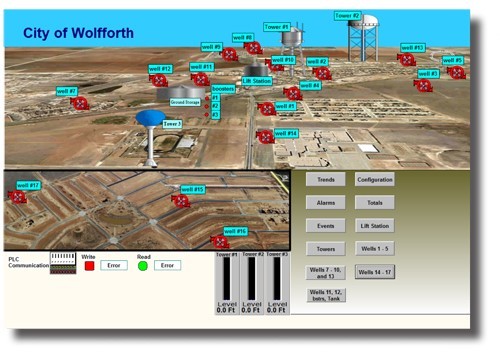Using SCADA for monitoring water and wastewater systems
Posted: January 13, 2021
Connecting SCADA system to the RTUs used to monitor and control water/wastewater systems is becoming simpler, easier and less expensive, especially with available SCADA software like AVEVA Edge. With drinking water distribution and wastewater collection systems often spread out over large geographical areas, automation and remote monitoring is crucial, and this is often accomplished by local RTUs, and local and/or remote SCADA systems.
The SCADA system can include several human machine interfaces (HMI) displays in the field, with AVEVA Edge software running on an industrial PC, or on a platform hosting an embedded operating system such as Windows Embedded or Linux. These HMIs connect to remote terminal units (RTU) used to automate the process, as well as HMIs in the main control center.
These HMIs collect operation and process data from one or many RTUs. This data can then be displayed on local monitors or, if configured, can be accessed by mobile devices such as smartphones, tablets or laptop computers. Let’s take a high-level view of connection options and HMI applications in a water/wastewater SCADA system.
What is a SCADA system for water?
In drinking water systems, elevated water storage tanks and gravity provide most of the energy to create flow to your faucet through underground pipes. Pumps are used to fill the tanks and may also be needed at strategic points to ensure adequate pressure in the water distribution system.

Gravity plays a much smaller role in wastewater collection. In these systems, the likely contaminated water requires lift stations to pressurize the water to move it to a water treatment plant.
Many field devices and sensors are used in pump and lift stations. These devices are usually connected to an RTU, typically a programmable logic controller (PLC). The RTU is used to automate the local process. A local HMI may connect to the RTU using an industrial Ethernet protocol such as EtherNet/IP, Modbus TCP/IP or Profinet.

Either the RTU or local HMI, if installed, connects to the SCADA system in the central control room, usually via an industrial Ethernet protocol. The central control room usually includes one or more HMIs that turn the raw process and operations data into usable information. This information is presented to the operators, technicians and engineers using the control room HMIs, or by remote connection to these HMIs using a tablet, for example.
There are many field device and RTU connection options and HMI implementations available to transform data into information for use by an operator. The complexity and cost of connecting to these field devices, RTUs, HMI and mobile devices continues to drop, so now is the time to get connected.
For more information, please contact us to learn more about applying AVEVA solutions to your Water/Wastewater project.
Related Blog Posts
Stay in the know: Keep up to date on the latest happenings around the industry.